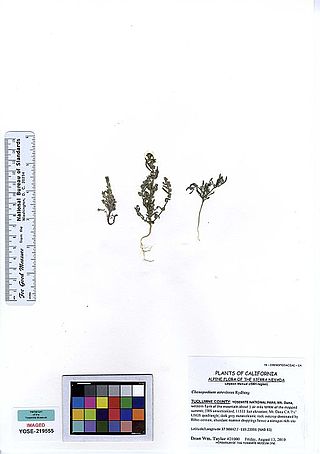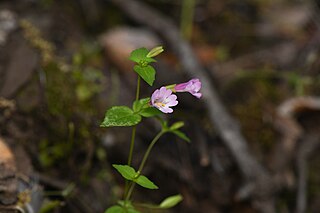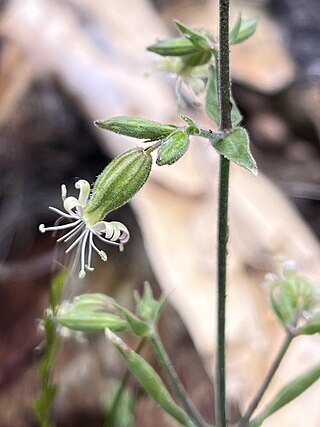
Mitella diphylla is a clump forming, open woodland plant native to northeast and midwest regions of North America.

Chenopodium atrovirens is a species of flowering plant in the amaranth family known by the common names pinyon goosefoot and dark goosefoot.

Lithophragma glabrum is a slender perennial western North American mountain plant in the Saxifrage family (Saxifragaceae), known by the common names bulbous woodland star, bulbiferous prairie-star, smooth woodland star, and smooth rockstar.

Erythranthe inconspicua, synonym Mimulus inconspicuus, is an uncommon species of monkeyflower known by the common name smallflower monkeyflower.

Brewerimitella breweri is a species of flowering plant in the saxifrage family, known by the synonyms Mitella breweri and Pectiantia breweri and by the common names Brewer's mitrewort and Brewer's bishop's cap. It is native to western North America from British Columbia to central California and Nevada, where it grows in moist meadows, woods, and mountain forests.
Pseudobahia heermannii is a species of flowering plant in the family Asteraceae known by the common names foothill sunburst and brittlestem.

Ranunculus eschscholtzii is a species of buttercup flower known by the common name Eschscholtz's buttercup.

Sidalcea glaucescens is a species of flowering plant in the mallow family known by the common name waxy checkerbloom.
Sidalcea hartwegii is a species of flowering plant in the mallow family known by the common names valley checkerbloom and Hartweg's checkerbloom.

Sidalcea hirsuta is a species of flowering plant in the mallow family known by the common name hairy checkerbloom.

Sidalcea oregana is a species of flowering plant in the mallow family known by the common name Oregon checkerbloom.

Sidalcea reptans is a species of flowering plant in the mallow family known by the common name Sierra checkerbloom and Sierra checker mallow.

Silene bridgesii is a species of flowering plant in the family Caryophyllaceae known by the common name Bridges' catchfly.
Silene nuda is a species of flowering plant in the family Caryophyllaceae known by the common names western fringed catchfly and sticky catchfly.

Silene occidentalis is a species of flowering plant in the family Caryophyllaceae known by the common names western catchfly and western campion.

Silene sargentii is a species of flowering plant in the family Caryophyllaceae known by the common name Sargent's catchfly. It is native to the western United States, where it is known from the mountain ranges straddling the California-Nevada border east of the Sierra Nevada. It is also known from one disjunct occurrence in central Washington. It grows in rocky mountain habitat in subalpine and alpine climates. It is a perennial herb growing from a woody, branching caudex and taproot, sending up several decumbent or erect stems and shoots. It grows no more than about 20 centimeters tall, often taking a clumpy form. The fleshy leaves are widely lance-shaped and a few centimeters in length, most of them occurring around the caudex. Each flower is encapsulated in a hairy, glandular calyx of fused sepals which has stark purple veining. The petals are white to deep pink and each has two or more rounded or pointed lobes at the tip.

Angelica capitellata, synonym Sphenosciadium capitellatum, is a species of flowering plant in the family Apiaceae. When treated as Sphenosciadium capitellatum, it was the only species in the monotypic genus Sphenosciadium. It is known by the common names woollyhead parsnip, ranger's buttons, button parsley, and swamp white heads.
Streptanthus farnsworthianus is an uncommon species of flowering plant in the mustard family known by the common name Farnsworth's jewelflower. It is endemic to California, where it is limited to the woodlands of the Sierra Nevada foothills. It is an annual herb producing a hairless, waxy, purple or purple-tinged stem up to half a meter tall or more. The ephemeral basal leaves have blades up to 15 centimeters long which are each divided into several narrow lobes or leaflets. Leaves higher on the stem have purple lance-shaped blades that generally clasp the stem at their bases. Flowers occur at intervals along the upper stem with one or two leaflike purple bracts at the base of the raceme. Each flower has an urn-shaped calyx of purple sepals up to a centimeter long. Curling purple-veined white petals emerge from the tip of the calyx. The fruit is a straight or curving silique up to 12 centimeters long.
Streptanthus fenestratus is an uncommon species of flowering plant in the mustard family known by the common name Tehipite Valley jewelflower.
Trifolium andersonii is a species of clover known by the common names fiveleaf clover and Anderson's clover. It is native to the western United States, particularly the Great Basin and adjacent high mountain ranges, including the Sierra Nevada. It was named after Charles Lewis Anderson by Asa Gray.














